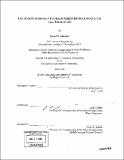| dc.contributor.advisor | Linda Griffith. | en_US |
| dc.contributor.author | Schreiber, Brent M. (Brent Matthew), 1981- | en_US |
| dc.contributor.other | Massachusetts Institute of Technology. Biological Engineering Division. | en_US |
| dc.date.accessioned | 2005-06-02T19:45:25Z | |
| dc.date.available | 2005-06-02T19:45:25Z | |
| dc.date.issued | 2004 | en_US |
| dc.identifier.uri | http://hdl.handle.net/1721.1/18045 | |
| dc.description | Thesis (M. Eng.)--Massachusetts Institute of Technology, Biological Engineering Division, 2004. | en_US |
| dc.description | Includes bibliographical references (leaves 84-93). | en_US |
| dc.description.abstract | Non-parenchymal cells (NPC's) are integral to recreate the native hepatic microenvironment and necessary to maintain in vivo liver function. A variety of in vitro culture systems have been developed to address different aspects of liver physiology and architecture in order to recreate the microenvironment. These in vitro co-culture strategies have been limited by their inability to systematically characterize the addition of non-parenchymal cells. In this dissertation, I use gene expression levels quantified by real-time RT-PCR to determine tissue composition. The identified genes demonstrate significant cell-type specificity, magnitude, and stability of expression in vivo and throughout each step of cell isolation process. In the course of this development, we establish protocols to accurately isolate and count an enriched fraction of primary NPC's. Experiments on the perfusion and isolation process prove that there exists an inverse correlation between perfusion flow rate and NPC yield and viability. Further, we have characterized the tissue composition of each step in the cell isolation process and the resulting NPC population to confirm that a significant number of each NPC type is delivered to in vitro co-culture. System output analysis of spheroids co-cultured at physiological ratios and seeded into the milliF bioreactor shows the presence of stellate cells, but the absence of endothelial (EC) and kupffer cells (KC). The same analysis of 2D collagen gel sandwiches shows the presence of all NPC cell types. This indicates that our process is currently limited by the ability of EC's and KC's to incorporate into spheroid aggregates. Future work that validates the temporal expression stability of the identified genes in different in vitro culture systems | en_US |
| dc.description.abstract | (cont.) and environments will enable determination of relative levels of NPC incorporation and will allow correlations to be made between operational features of in vitro systems, the resulting culture microenvironment, and observed tissue function. | en_US |
| dc.description.statementofresponsibility | by Brent M. Schreiber. | en_US |
| dc.format.extent | 120 leaves | en_US |
| dc.format.extent | 8006001 bytes | |
| dc.format.extent | 8020925 bytes | |
| dc.format.mimetype | application/pdf | |
| dc.format.mimetype | application/pdf | |
| dc.language.iso | eng | en_US |
| dc.publisher | Massachusetts Institute of Technology | en_US |
| dc.rights | MIT theses may be protected by copyright. Please reuse MIT thesis content according to the MIT Libraries Permissions Policy, which is available through the URL provided. | en_US |
| dc.rights.uri | http://dspace.mit.edu/handle/1721.1/7582 | |
| dc.subject | Biological Engineering Division. | en_US |
| dc.title | Use of gene expression to characterize heterogeneous liver cell populations | en_US |
| dc.title.alternative | Characterization of heterogeneous hepatic cell population via use of gene expression | en_US |
| dc.type | Thesis | en_US |
| dc.description.degree | M.Eng. | en_US |
| dc.contributor.department | Massachusetts Institute of Technology. Department of Biological Engineering | |
| dc.identifier.oclc | 57364170 | en_US |
